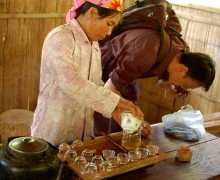
Our third day of our Yunnan Tour brought us the Nannuoshan one of the Six Famous Mountains of Xishuanbanna (which Google calls Sipsongpanna, I’m not sure why) in Menghai County. Of course Menghai is very well known because of the big government factory that had evolved and been rebranded into Da Yi. Menghai (Dayi) has been well marketed for having puer that comes from ancient trees, although a large number of these old trees are to be found in Menghai County, Dayi gets only a very small amount. The majority of their tea come from what is ‘taidicha’. Taidicha (terraced tea) is production commercial tea, and at most is only as old as the late 60’s early 70’s when Mao forced Menghai and many other counties to grow a high yield cultivar. They cleared forests by burning, and build terraces. The resulting crops needed a lot of fertilizer and insecticides because it was no longer part of the local biodiversity. As you can see from our photos, ‘dashucha’ (big tree tea) is very much a part of the surrounding forests. Actually only 5 to 7% of the puer produced in all of Yunnan comes from trees that are a hundred years old. We did visit a large grove of ancient trees high up in Nannuoshan, famous for dashucha.
We hiked for about an hour and a half to visit an eight hundred year old tree. The forest was so loud with the sound of insects that all of videos were drowned out with their singing. We also found many ancient osmanthus trees that reached the sky and had trunks like giant redwoods. The forest floor was sprinkled everywhere with the sweet smelling blossoms. We found a tea house by the eight hundred year old tea tree, where we happily drank tea and brought back a few unlabeled cakes that the tea house lady had there with her. She doesn’t get many visitors but she stands watch over the tree with is still picked. Along our hike we passed some very large trees that were not as tall and much bushier that the old tree, that were being used only for seed and were no long picked. This tea is identified as authentic by experienced tasters for having two distinct and brief spikes of bitterness that pass very quickly, one early in the sip, and one later. No other tea has this characteristic, only the ancient trees from Nannuo mountain. it is also very expensive. I am talking about sheng (raw, green) puer. This tea, many Chinese feel, requires the most sophisticated palate to appreciate. The best maocha only goes to sheng puer and is never wasted on shu (cooked, black) puer. We are only looking for sheng puer on our trip that has been made from the leaves of old trees in the various counties we are visiting.
Austin
